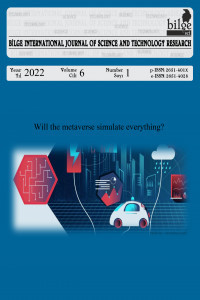Grafen Takviyeli PS Kompozitlerinin Yapisal, Isil Ve Mekanik Özelliklerinin İncelenmesi
Nanokompozit, grafen, plastik enjeksiyon
Investigation of Structural, Thermal and Mechanical Properties related to Graphene Reinforced PS Composites
Nanocomposites, graphene, plastic injection,
___
- Ateş, S. (2011). SiC takviyeli etial 21 esaslı kompozit malzemelerin basınçlı infiltrasyon yöntemi ile üretimi ve özelliklerinin incelenmesi. Doktora Tezi, Kırıkkale Üniversitesi, Fen Bilimleri Enstitüsü, Makine A.B.D., Kırıkkale, 1, 43-51.
- Nieto, A., Boesl, A. B. (2015). Agarwal, Multi-scale intrinsic deformation mechanisms of 3D graphene foam. Carbon, 85 299-308.
- Qiu, L., He, Z., Li, D. (2017). Multifunctional cellular materials based on 2D nanomaterials: prospects and challenges. Advance Materials, 30, 1-15.
- Wei, W., Qu, X. (2012). Extraordinary physical properties of functionalized graphene. Small, 8, 2138-2151.
- Liem, H., Choy, H.S. (2013). Superior thermal conductivity of polymer nanocomposites by using graphene and boron nitride as fillers. Solid State Commun, 163, 41-45.
- Balandin, A., Suchismita, G., Wenzhong, B., Irene, C., Desalegne, T., Feng, M., (2008). Superior thermal conductivity of single-layer graphene. Nano Lett, 8, 902-907.
- Bustillos, J., Montero, D., Nautiyal, P., Loganathan, A., Boesl, B. (2017). Integration of Graphene in Poly ( Lactic ) Acid by 3D Printing to Develop Creep and Wearresistant Hierarchical Nanocomposites, 3877-3888.
- Khan, Z.U., Kausar, A., Ullah, H., Badshah, A., Khan, W.U. (2015). A review of graphene oxide, graphene buckypaper, and polymer/graphene composites: Properties and fabrication techniques. Journal of Plastic Film & Sheeting, 32(4), 336–379.
- Wang, Y., Zhiqiang, S., Yi, H., Yanfeng, M., Chengyang, W., Mingming, C., et al., (2009). Supercapacitor devices based on graphene materials. Journal of Physical Chemistry, 113, 103-107.
- Choi, B.G., Yang, M., Hong, W.H., Choi, J.W., Huh, Y.S. (2012). 3D macroporous graphene frameworks for supercapacitors with high energy and power densities. ACS Nano, 6, 4020-4028.
- Shi, L., Yang, J., Yang, T., Hanxun, Q., Zheng, Q. (2014). RSC Advances Molecular level controlled fabrication of highly transparent conductive reduced graphene oxide/silver nanowire hybrid films. RSC Advances, 4, 3270-3277.
- Karademir, İ. (2013). SiO2 takviyeli etial 21 esaslı kompozit malzemelerin basınçlı infiltrasyon yöntemi ile üretimi ve özelliklerin incelenmesi. Yüksek Lisans Tezi, Bartın Üniversitesi, Fen Bilimleri Enstitüsü, Makine Mühendisliği A.B.D., Bartın.
- Soria-Verdugo, A., Goos, E., García-Hernando, N. (2015). Effect of the number of TGA curves employed on the biomass pyrolysis kinetics results obtained using the distributed activation energy model. Fuel Processing Technology, 134, 360-371.
- Ersoy, M.S. (2005). Lif takviyeli polimerik kompozit malzeme. Yüksek Lisans Tezi, Kahramanmaraş Sütçü İmam Üniversitesi, Fen Bilimleri Enstitüsü, Tekstil Mühendisliği A.B.D., Kahramanmaraş.
- Dreijers, I., Medne O. (2006.). Analysis of the Expanded Polystyrene Manufacturing Technology. Riga Technical University 47th International Scientific Conference. Riga, Latvia. October 12 - 14.
- Medne, O., Dreijer, I., Berzina, L. (2010). Cimdina. Influence of preexpansion conditions of inner structure of expanded polystyrene granules. Riga Technical University 51st International Scientific Conference. Riga, Latvia. October 11-15.
- Chen, G., Wu, C., Weng, W., Wu, D., Yan, W., (2003). Preparation of polystyrene/graphite nanosheet composite. Polymer, 44, 1781.
- Dikin, D.A., Stankovich, S., Zimney, E.J. (2007). Preparation and characterization of graphene oxide paper. Nature, 448, 7152, 457-460.
- Novoselov, K.S., Geim, A.K., Morozov, S.V., Jiang, D., Zhang, Y., Dubonos, S.V. (2004). Electric field effect in atomically thin carbon films. Science, 306, 666-669.
- ISSN: 2651-401X
- Yayın Aralığı: Yılda 2 Sayı
- Başlangıç: 2017
- Yayıncı: Kutbilge Akademisyenler Derneği
Treatment of Rose Processing Wastewater By Sunlight/TiO2 Photocatalysis Process
Melda BAŞBUĞ ÇANCI, Mehmet KILIÇ
Isıl İşlem Görmüş Kızılçam (Pinus brutia Ten.) Yongalarından Üretilen Levhaların Bazı Özellikleri
Samim YAŞAR, Aytaç UZ, Abdullah BERAM
Ylli KORTOCİ, Mirvjena KELLEZİ
Hydrodistillation of Nigella Sativa Seed and Analysis of Thymoquinone with HPLC and GC-MS
Ümit ERDOĞAN, Mustafa YILMAZER, Sabri ERBAŞ
Grafen Takviyeli PS Kompozitlerinin Yapisal, Isil Ve Mekanik Özelliklerinin İncelenmesi
Kadir GÜNDOĞAN, Damla KARAAĞAÇ
A Tool Development for Test Case Based Code Optimization in Java
